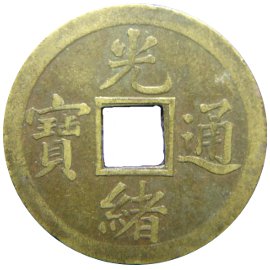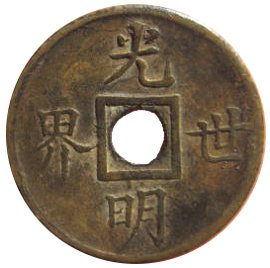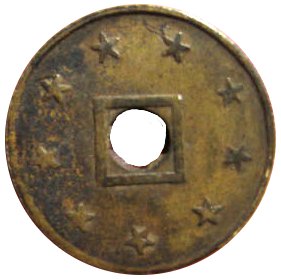
Qing Dynasty Machine Struck Cash Coin
The first Chinese machine-made cash coins were minted during the reign (1875-1908) of Emperor De Zong of the Qing Dynasty.
As seen at the left, these brass coins had the inscription guang xu tong bao (光緒通寶). Many of these coins were struck at the mint in Guangzhou, Guangdong Province during the years 1889-1908.
Another coin was made about the same time that closely resembles this common guang xu tong bao coin but its meaning and history are still a mystery.

An example of this mysterious coin is shown at the left. The inscription reads guang ming shi jie (光明世界) which translates as “world of brightness”.
Several theories have been proposed as to the meaning and purpose of this coin or charm.
Many people believe that this is “spirit money” (ming qian 冥钱), also known as “ghost money”, “hell money” or “joss money”, which is money that is buried with the dead.
The reasoning is that this coin resembles real Chinese money. Also, the inscription “world of brightness” is a euphemism for “world of darkness” or death.
A different theory proposes that the coin is associated with the Tiandihui (天地会) or “Heaven and Earth Society” which was a secret organization dedicated to overthrowing the Qing Dynasty, which was ruled by the Manchus, and restoring the Ming Dynasty and the hegemony of the Han people. Interestingly enough, the inscription on the coin uses the same character “ming” (明) that is used for Ming Dynasty (明朝), and the inscription guang ming (光明) can be interpreted to mean the “glory of the Ming”.
One final theory is that the coin was made to be used as a game piece or gambling token.
This coin is know to exist in three varieties with the difference being the reverse sides.
The most commonly found reverse side is identical to that of the standard guang xu tong bao coin. In this case, there are two Manchu characters indicating that the coin was struck at the mint in Guangzhou.
The second version of the coin has a reverse side that is identical to the obverse side which means that the same inscription or legend is on both sides.

The third version of the coin is the most interesting because it has nine stars as shown in the example at the left.
The ancient Chinese, and particularly the Daoists, believed that the star constellation known as the “Big Dipper” or “Ladle” (beidou 北斗) consisted of the seven stars we see today along with two “invisible” or “attendant” stars making a total of nine stars.
The “Big Dipper” was where the gods lived and also served as the emperor’s chariot.
One of the major Buddhist and Daoist deities is the “Dipper Mother” (doumu yuanjun 斗母元君) who is also known as the “Queen of Heaven” (tianhou 天后) and the “Goddess of Beidou (“Big Dipper”)”.
She is the mother of the Nine Emperor Gods who are represented by the nine stars. She is honored each year on the 9th day of the 9th lunar month.
Finally, “nine” (jiu 九) is an auspicious number to the Chinese because it has the same pronunciation as the word “forever” (jiu 久).
While questions remain as to the true meaning and purpose of this coin, it nevertheless provides a fascinating insight into the political undercurrents and religious beliefs of China just as the imperial system that had existed for more than 2,000 years was beginning to crumble.
I purchased the above coin / token ? with the 9 star obverse from a coin dealer in Kowloon in 1983. I was told at that time that this particular piece was a commemorative item issued after the death of Emperor De Zong, and that This Bright World was the translation
I seem to recall that this dealers name is Wan Yin Man. ?? The mint was Guangdong, however he was uncertain what year it was struck. Cheers Peter.
Just to add weight to my earlier comment. Emperor De Zong had the reign title of Guang Xu (translates as Bright succession) This bright world coin when read from top to bottom reads Guang Ming. Guang translates as BRIGHT and Ming translates as BRIGHT also, a succession of the word BRIGHT. To my way of thinking this indicates the two coins were produced for the same Emperor. As for the 9 star reverse ? Well the Guang Xu Emperor was the 9th Qing Dynasty Emperor to rule over a unified China, more than likely the 9 stars are for the 9 Qing Dynasty Emperors that had passed away, or as the saying goes :– Left this world to be re united with their ancestors. Regards Peter.